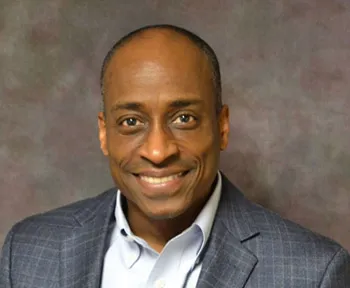Collaboration Fuels Analysis of Social Mobility

Centennial Professor of Economics Philip Jefferson
When Centennial Professor of Economics Philip Jefferson was asked to present at a conference on human capital and mobility hosted by the Federal Reserve Bank of Minneapolis, he knew he would need a compelling data set if he was going to tackle his intended subject. Little did he know that data he was searching for would come from a student in his Advanced Econometric seminar. Watch his presentation below.
For his presentation, which took place in late May, Jefferson analyzed if it was possible for someone to move up the income ladder within their lifetime and if that correlates with what college they attended. Aiding in this analysis was a data set created by John Calia ’18, an economics and mathematics major from Kinnelon, N.J.
“I was honestly surprised that a professor was asking for permission to use my work; this is something I've never experienced, so of course I would say yes,” Calia says.
Caila created the data set for a paper in Jefferson’s seminar entitled Can College Rankings be Trusted? He wanted to know if college ranking systems were reflective of measures of post-college success (monetary, academic, or based on personal satisfaction), so he collected starting salaries and mid-career salaries for graduates from 963 schools using website Payscale.com.

John Calia '18
This data turned out to be exactly what Jefferson needed for this study.
“I was able to use John’s rich data set to look at the question – how does someone’s early career pay and mid-career pay relate to which college they attended? John’s data was exactly what I was looking for.”
What Jefferson found from his study was a surprising– and somewhat sobering– result: if you are behind someone early in their career, by the time you get to mid-career, you are still going to be behind that person. And the only way you could have caught up was by going to a different school.
“What we showed is that the relationship between early-career pay and mid-career pay is linear and positively sloped. And very importantly, that slope indicated once you graduate from a school, you were not going to be able to catch up to somebody that gradated from a different school that started with a different pay. If you start out 10 percent behind, you are still going to be 10 percent behind mid-career.”
Jefferson is quick to note that the data only accounts for those with only bachelor’s degrees and that a college education is worth more than what someone pays for it. Still, he believes the findings have significance because “student debt loads are so high that it’s understandable that parents and students care about outcomes like pay.”
As for Calia, he believes that being cited as a collaborator for one of his professor’s projects will be one of his lasting memories of the College.
“Looking back, this project proved once again to me how good we have it as undergrads at Swarthmore. Professor Jefferson rightly stated in the introduction of his presentation that this sort of collaboration is reserved for grad students at most other colleges and universities.”



